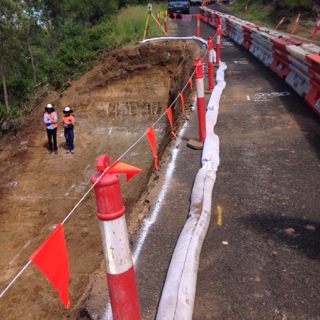Title Page
-
Site conducted
-
Conducted on
-
Prepared by
-
Location
-
The site inspection focuses on the implementation of risk controls used by contractors following the work health and safety (WHS) management plan assessment. The intent of the site inspection is to benchmark the safety practices observed on site against the criteria contained in the checklist. It is understood that construction sites are continuously changing and vary greatly in size and complexity. For this reason, it may not be possible for the auditor to examine all plant and work practices for a particular project. It is acceptable to review a sample of items and, based on the evidence that is available at the time, assess whether the undertaking conforms to the set criteria
Principal Contractor Details
-
Business address
-
Contact person
-
Phone
-
Email
Site Representative Details
-
Name
-
Position
-
Level of involvement in the project
Project Details
-
Project name
-
Scope of work
Housekeeping
-
The layout of the workplace allows, and the workplace is maintained so as to allow, for people to enter and exit and to move about without risk to health and safety, both under normal working conditions and in an emergency.<br>Work Health and Safety Regulation 2011 s.40<br>
-
The principal contractor has managed the risks to health and safety associated with the storage, movement, and disposal of construction materials and waste at the workplace.<br>Work Health and Safety Regulation 2011 s.315<br>
-
The entries, exits, and access ways in the workplace are kept clean and clear of materials and waste.<br>Work Health and Safety Regulation 2011 s.40<br>
-
A safe system has been implemented for the collection, storage, and disposal of excess or waste materials.<br>Work Health and Safety Regulation 2011 s.40<br>
-
Sufficient area has been allocated to safely store materials or plant for the construction work.<br>Work Health and Safety Regulation 2011 s.40 and s.315<br>
-
Protruding objects that are a hazard have been made safe (e.g. exposed nails, vertical reinforcing steel).<br>Work Health and Safety Regulation 2011 s.40<br>
Amenities
-
Adequate facilities have been provided for workers, including toilets, drinking water, washing facilities, and eating facilities.<br>Work Health and Safety Regulation 2011 s.41<br>
-
Facilities provided for workers are in good working order and are clean, safe, and accessible.<br>Work Health and Safety Regulation 2011 s.41<br>
-
Amenities are maintained in a hygienic, safe, and serviceable condition through a system for inspecting and cleaning the amenities.<br>Work Health and Safety Regulation 2011 s.315A<br>
-
At least one toilet has been provided for each 15, or part of 15, construction persons.<br>Work Health and Safety Regulation 2011 Schedule 5A, Part 2 Toilets<br>
-
Toilets are provided in accordance with the regulations, including the requirements for:<br>• the accessibility of toilets for multi-story structures of at least four levels<br>• whether toilets should be connected or portable<br>• privacy, ventilation, and toilet paper<br>• specific facilities for the hygienic disposal of sanitary items for females.<br>Work Health and Safety Regulation 2011 s.315A and Schedule 5A, Part 2 Toilets<br>
-
A room or sheltered area to eat meals and take breaks in, is reasonably available to each construction person and complies with the requirements relating to:<br>• hygiene<br>• separation from work activities that expose or are likely to expose construction workers to a health or safety risk<br>• adequate space and seating<br>• appropriate facilities for washing and storing utensils, boiling water, and storing food in a cool place.<br>Work Health and Safety Regulation 2011 Schedule 5A, Part 3 Other amenities<br>
-
Adequate clean water for washing the hands and face supplied through an appropriate facility are reasonably available to each construction person.<br>Work Health and Safety Regulation 2011 Schedule 5A, Part 3 Other amenities<br>
-
An appropriate and adequate supply of potable, clean, and cool drinking water is reasonably available to each construction person.<br>Work Health and Safety Regulation 2011 Schedule 5A, Part 3 Other amenities<br>
First aid
-
First aid equipment has been provided for the workplace and is accessible to each worker.<br>Work Health and Safety Regulation 2011 s.42<br>
-
An adequate number of workers have been trained to administer first aid.<br>Work Health and Safety Regulation 2011 s.42<br>
-
The first aid provisions for the workplace are appropriate to the:<br>• nature of the work being carried out<br>• nature of the hazards at the workplace<br>• size and location of the workplace<br>• number and composition of the workers and other people at the workplace.<br>Work Health and Safety Regulation 2011 s.42<br>
Single or extension ladders – access only (i.e. no construction work or permitted work)
-
Note: This criterion does not apply to permitted work, as defined by s306A.<br>Single or extension ladders are only used to gain access to a place (i.e. not to perform construction work).<br>Work Health and Safety Regulation 2011 s.306K<br>
-
When using a single or extension ladder to gain access to a place, workers maintain at least two hands and one foot, or two feet and one hand, on the ladder from when the person is fully on the ladder to when the person is leaving the ladder.<br>Work Health and Safety Regulation 2011 s.306K<br>
Single or extension ladders – construction work that is permitted work Note: The criteria under this heading only apply where a person performing the permitted work from a single or extension ladder could fall at least 3m for housing construction work, or at least 2m for all other construction work.
-
The person using the single or extension ladder:<br>• has at least three limbs holding, wrapped around, or standing on the ladder in any combination, or is holding a stable object with one or both hands instead of the ladder, or<br>• is prevented from falling by a control measure, or<br>• is using a fall arrest harness system that is not attached to the ladder.<br>Work Health and Safety Regulation 2011 s.306L<br>
-
Each single or extension ladder is secured at the top or the bottom to prevent it moving.<br>Work Health and Safety Regulation 2011 s.306L<br>
-
A single or extension ladder used against a pole to do construction work has a device fitted at or near the top of the ladder between its sides that helps to ensure the ladder’s stability by partly accepting the shape of the pole.<br>Work Health and Safety Regulation 2011 s.306L<br>
Ladders generally Note: The criteria under this heading do not apply to trestle ladders.
-
Ladders have a load rating of at least 120kg and have been manufactured for industrial use.<br>Work Health and Safety Regulation 2011 s.306M<br>
-
Ladders are used only for the purpose for which they have been designed.<br>Work Health and Safety Regulation 2011 s.306M<br>
-
Ladders are not used to support a weight greater than that for which they have been designed.<br>Work Health and Safety Regulation 2011 s.306M<br>
-
Note: This criterion does not apply to ladders used in confined spaces.<br>Ladders are no longer than:<br>• 6.1m for single ladders<br>• 9.2m for extension ladders used to do electrical work within the meaning of the Electrical Safety Act 2002<br>• 7.5m for other extension ladders.<br>Work Health and Safety Regulation 2011 s.306M<br>
-
Ladders are used where the:<br>• bottom of the ladder is on a stable surface<br>• rungs of the ladder are approximately level.<br>Work Health and Safety Regulation 2011 s.306M<br>
-
Ladders are not used to support a platform.<br>Work Health and Safety Regulation 2011 s.306M<br>
-
Single or extension ladders are only used at the appropriate angle, as per the regulations.<br>Work Health and Safety Regulation 2011 s.306M<br>
Work on platform supported by trestle ladders Note: The criteria below must be complied with before construction work is carried out on the platform supported by trestle ladders where the person performing the work could fall at least 3m, for housing construction work, or at least 2m for all other construction work.
-
Each trestle ladder is secured to prevent it from moving.<br>Work Health and Safety Regulation 2011 s.306N<br>
-
Edge protection that complies with the regulations has been erected along the outer edge of the length of the platform.<br>Work Health and Safety Regulation 2011 s.306N<br>
-
Control measures are in place to eliminate or minimise the risk of a person falling off the inner edge or the end of the platform.<br>Work Health and Safety Regulation 2011 s.306N<br>
Platform supported by trestle ladders
-
Platforms are unobstructed.<br>Work Health and Safety Regulation 2011 s.306O<br>
-
For construction work being carried out on a platform supported by trestle ladders where there is a risk that the person carrying out the work could fall less than 3m, for housing construction, or less than 2m for all other construction:<br>• for light work, as defined by the regulations, the platform is at least 225mm wide along its entire length, or<br>• for all other work the platform is at least 450mm wide along its entire length.<br>Work Health and Safety Regulation 2011 s.306O<br>
-
For construction work being carried out on a platform supported by trestle ladders where there is a risk that the person carrying out the work could fall at least 3m, for housing construction, or at least 2m for all other construction:<br>• the platform is at least 450mm wide along its entire length<br>• the platform is not higher than 5m.<br>Work Health and Safety Regulation 2011 s.306O<br>










